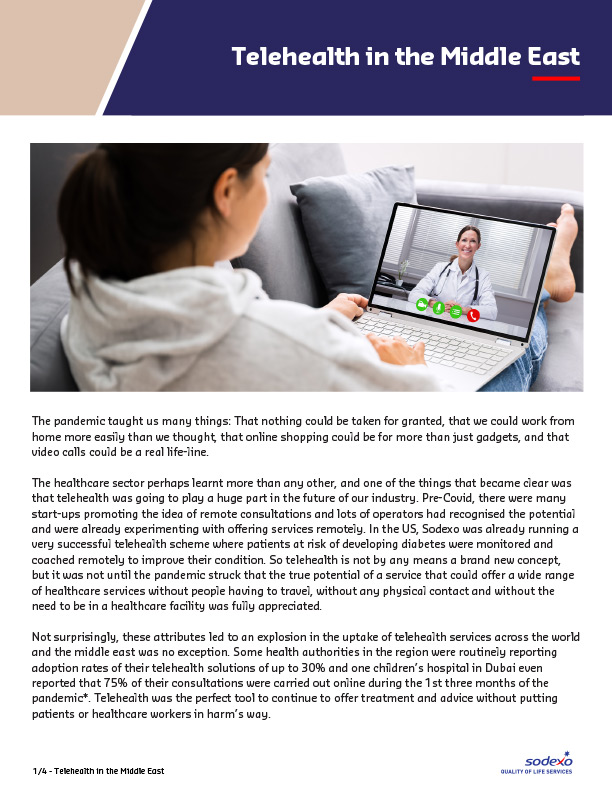Now that the worst of the pandemic seems to be behind us, will telehealth continue to have a big role to play in the provision of healthcare?
The pandemic taught us many things: That nothing could be taken for granted, that we could work from home more easily than we thought, that online shopping could be for more than just gadgets, and that video calls could be a real life-line.
The healthcare sector perhaps learnt more than any other, and one of the things that became clear was that telehealth was going to play a huge part in the future of our industry. Pre-Covid, there were many start-ups promoting the idea of remote consultations and lots of operators had recognised the potential and were already experimenting with offering services remotely. In the US, Sodexo was already running a very successful telehealth scheme where patients at risk of developing diabetes were monitored and coached remotely to improve their condition. So telehealth is not by any means a brand new concept, but it was not until the pandemic struck that the true potential of a service that could offer a wide range of healthcare services without people having to travel, without any physical contact and without the need to be in a healthcare facility was fully appreciated.
Not surprisingly, these attributes led to an explosion in the uptake of telehealth services across the world and the middle east was no exception. Some health authorities in the region were routinely reporting adoption rates of their telehealth solutions of up to 30% and one children’s hospital in Dubai even
reported that 75% of their consultations were carried out online during the 1st three months of the pandemic*. Telehealth was the perfect tool to continue to offer treatment and advice without putting patients or healthcare workers in harm’s way.

But what now?
Now that the worst of the pandemic seems to be behind us, will telehealth continue to have a big role to play in the provision of healthcare?
It seems clear that some of the features and benefits which drove the uptake of telehealth from a consumer point of view will remain equally attractive as we move forward.
- Virtual appointments
- Secure messaging
- Remote diagnostics
- No exposure to infections
- Convenience - No travel required
- Cheaper consultations
And likewise, from a healthcare provider point of view, the benefits are clear:
- Costs are lower than in-person care
- Clinicians can work from anywhere
- More patients can be seen in a shorter time
- Physical locations can be optimised for those that do require in-person care
Obstacles to Growth
We need to bear in mind though that there are still significant obstacles to overcome if telehealth is to become a mainstream way of providing healthcare, for example:
- Health care is an intensely personal part of life and many people would still prefer in-person care rather than a phone call or a video call.
- The older generation who as a portion of the population require more healthcare, are often less inclined to use new technology.
- Personal data confidentiality is a big topic and many will have concerns about the privacy and security of their most personal data.
Wearables
Notwithstanding these concerns, if we look to the near future we can see that the phenomenal growth in wearable tech and other forms of remote diagnostics is destined to continue. Wearable devices that can monitor blood pressure, blood sugar and heart conditions are already starting to appear on the market, and smartwatches can now routinely carry out ECG scans and identify potential issues. It doesn’t take too much imagination to see a time where routine check-ups for blood pressure, diabetes and other chronic conditions can take place, at least in part, without the patient and clinician having to be in the same space.

These developments have the potential to detect conditions earlier, leading to treatments and interventions that are less invasive, more effective, cheaper and which can lead to more positive outcomes. An aim that we can all get behind.
The Future
It seems clear then, that telemedicine is here to stay. Many of the legitimate concerns people have should ease over time as these tools become more common. With cost, time and convenience benefits and obvious advantages for insurance companies and healthcare providers, all the ingredients are there for telehealth to be a big part of the future of healthcare provision. Estimates suggest that growth rates in the MENA market for telemedicine will top 10.8% annually over the next 5 years*
That’s not to say that technology can (or should) replace in-person care, but it can act as a great compliment and a tool to identify potential issues before they become problems.
With a comparatively young and increasingly tech-minded population in the Middle East combined with widespread access to technology, and a healthcare system that for some is prohibitively expensive to access, telehealth can play a big part in the healthcare mix of this region.
- The boom of telehealth in UAE: Is it here to stay? Sept 2020 - https://insights.omnia-health.com/technology/boom-telehealth-uae-it-here-stay
- Middle East & Africa Telemedicine Market Analysis - April 2021 - https://www.marketdataforecast.com/market-reports/mea-telemedicine-market

